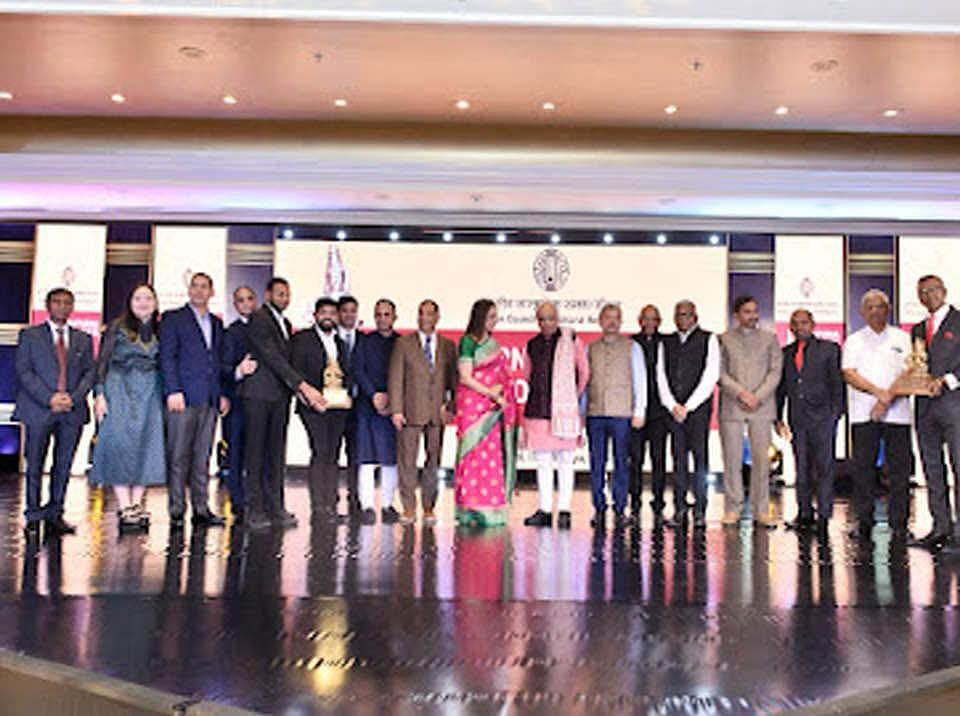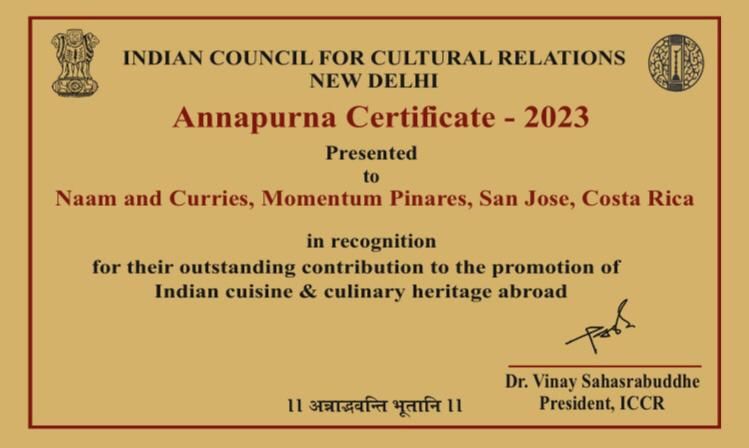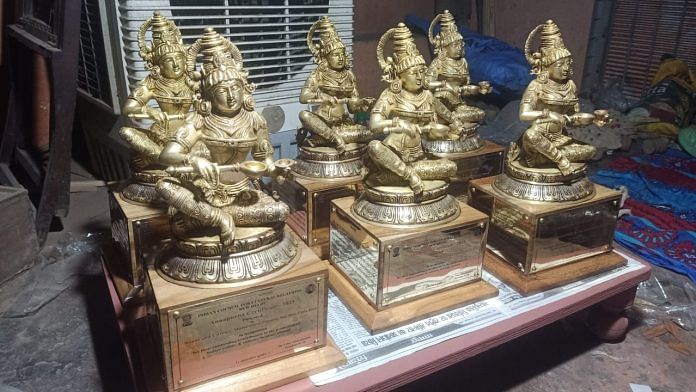New Delhi: Move over, Michelin stars. The Indian government has a new rating scale for restaurants abroad—the Annapurna Award.
In the maze of hundreds of Taj Mahal-named Indian restaurants playing sitar music and serving ‘curry’, the Narendra Modi government now wants to guide customers on what’s authentic and what’s not. It is a new form of cultural diplomacy. And if food is the language of diplomacy, the Indian Council for Cultural Relations (ICCR) is saying ‘feast on’ with star ratings. This is the next frontier of India’s foreign outreach.
‘Desi’ restaurants selling Indian food abroad can receive the Annapurna Certificate—an award by the ICCR to recognise and honour restaurants promoting India’s culinary traditions internationally. The certificate also seeks to recognise restaurants that expand the horizons of Indian cuisine, pushing past the stereotypes about Indian food being “smelly” and “spicy”.
These restaurants are officially India’s global ambassadors of food, and the Indian government is giving them a Goddess Annapurna-shaped-stamp of approval.
A total of 120 restaurants vied for the award in 2023, with six winning at an awards ceremony in December. The first batch of winners reflects diversity. The American Amber India Restaurant and Mumtaz Mahal Restaurant in Muscat, Oman, cater not only to diaspora populations but also to local communities, gaining recognition for their classic Indian fare. Balaji Dosai in Kandy, Sri Lanka, has become a cult favourite for North Indian food in a region that shares culinary similarities with South India. Sweden’s Indian Street Food & Co., Mongolia’s Namaste India, and Costa Rica’s Naans and Curries round out the inaugural list of 2023 winners. In 2024, the ICCR received 16 nominations, though winners have yet to be announced.
Indian embassies and high commissions across the world receive restaurant nominations, which are then examined by a jury committee put together by the ICCR. The selection criteria are strict and simple: the restaurant must have been operational for at least five years and serve at least 5,000 customers a month.
This diplomatic push highlights the Modi government’s emphasis on cultural diplomacy, especially as the Indian diaspora grows in both numbers and influence in countries like the US and the UK.

“The Annapurna Certificate is a flagship initiative that I’m extremely happy about,” said diplomat Nandini Singhla, the new Director General of the ICCR and former Ambassador to Mauritius. “It’s heartening to see such emphasis placed on restaurants promoting Indian culture abroad.”
Chef Garima Arora—the first Indian woman to win a Michelin star—is aware of the Annapurna award and is thrilled that the Indian government is recognising the global appeal of Indian food.
“Food is soft power which is such low-hanging fruit. I wish we would just grab it and go for it,” said Arora, who runs a modern Indian fine-dining restaurant in Bangkok. “Indian food is something people all over the world enjoy. Not just do they find it delicious, people are more and more interested in the history and anthropology of cooking and the regional complexities of it all.”
Also read: Sanskrit to satellites, embassies in Delhi are using culture to show ties, get close to India
Promoting Indian traditions
India isn’t just the land of Bollywood and Ayurveda. Nor is it just the land of tandoori chicken and ubiquitous tomato-based curries. This is exactly what the ICCR is trying to highlight with its Annapurna Award.
Indian food’s global appeal has long been undeniable—so much so that even neighbouring countries use Indian names for their restaurants abroad. Chicken tikka masala, for instance, is often considered the UK’s “national dish,” reflecting the influence of South Asian communities. Yet, for years, Indian cuisine abroad was boxed into stereotypes—predictable menus of curry, naan, and butter chicken served in restaurants adorned with tinsel and plastic tablecloths.
“One of the aspects of Indian soft power is our culinary tradition,” said Vinay Sahasrabuddhe, former ICCR president under whose tenure the programme was launched. “Indian restaurants are very popular abroad—even some of our notorious neighbours use Indian names for their restaurants. The Annapurna Certificate scheme is meant to recognise the skill of Indian restaurants abroad.”

It’s extremely common—especially in the West—to see ambiguously “desi” restaurants, with Bangladeshi, Pakistani, and Nepali immigrants selling Indian food because it is more recognisable. Manhattan’s famous Little India in the East Village is home to several such restaurants stacked along ‘Curry Row’—many run by Bangladeshi immigrants serving North Indian fare.
The Annapurna Award, however, does not restrict itself to purely Indian-owned establishments. According to the ICCR, the jury will consider any recommendations from local Indian missions, as long as the restaurant promotes Indian and South Asian cuisine in the region.
Chef Arora acknowledges that this overlap is common and says Indian chefs have played a role in reinforcing stereotypes.
“For the longest time, we’ve exported a version of food which is just curries and naans—Indian food is so much more [than] those stereotypical dishes,” she said. “Anywhere you go in the world, restaurants—whether Bangladeshi or Pakistani—always have an Indian name or are touted as serving Indian foods. Historically, it is “Indian” food, no doubt,” she added.
For decades, such restaurants flourished as waves of immigration created both supply and demand, particularly in the US and the UK during the 1980s. Now, the ICCR’s recognition reflects the growing awareness and appetite for India’s diverse regional cuisines.
“India is a spiritual democracy, and all our traditions are rooted in philosophy – food is no different,” said Sahasrabuddhe. “It is not surprising that other cultures are drawn to Indian culture and food. India has always retained its culture and identity, which is why others are attracted to it.”
Also read: India must tap into its cultural economy to become a global power
Global ambassadors of food
The Annapurna Award is a far cry from celebrity-run restaurants like Priyanka Chopra’s Sona in New York City or Michelin-starred establishments. Instead, it recognises everyday restaurants—the hidden gems that might have been the first window into India’s diverse cuisine for local people abroad.
Food is a cornerstone of Indian culture, and the Annapurna programme is part of a concerted effort by the ICCR to promote Indian culinary traditions globally.
“The certificate serves as a symbol of appreciation for the significant role these restaurants play in introducing Indian gastronomy to local communities abroad and enhancing cultural exchange,” said Abhay Kumar, deputy director general of the ICCR.
The award itself is a plaque and certificate “crafted on a trophy of Devi Annapurna,” and it holds lifetime validity. Indian missions in the six wining countries hosted special ceremonies last December, attended by the Heads of Missions, to present the awards.
Beyond recognition, the ICCR lists several distinct objectives for the programme—fostering cultural exchange, showcasing the diversity of Indian cuisine, and promoting international collaboration.
At its heart, though, the award honours the dedication and hard work of immigrants who have tirelessly cooked and served Indian food in unfamiliar lands.
“Indian restaurants are often the only link an immigrant has to their home,” said a diplomat who requested anonymity. “Such restaurants not only become a portal for the customer but also stand as a testament to the hard work of those who run such restaurants in countries where even familiar ingredients can be hard to come by.”
Indian missions abroad are aware of this role, said Arora, who works closely with the Indian embassy in Thailand.
“Food is the first thing that brings people together, isn’t it? Whether it’s a VVIP state visit or a friend visiting from abroad—the first thing you do is give them a taste of home,” she said.
Now, Arora said the next step is to generate similar excitement within India. And that involves cutting through red tape and supporting Indian chefs—from easing restrictions in importing world-class ingredients and wines to inviting Michelin to expand into India.
“Indian chefs leave India and make world-class restaurants. What’s stopping them from making that in India? It’s about time we change that,” she said. “Given this soft power and the interest that’s been generated abroad, I think we can do so much and generate so much more interest and tourism within the country too.”
(Edited by Prashant)






